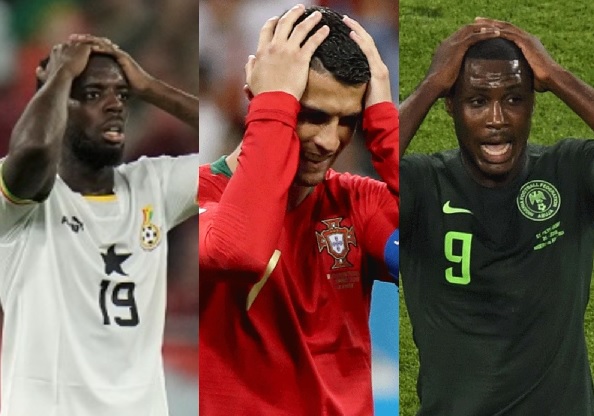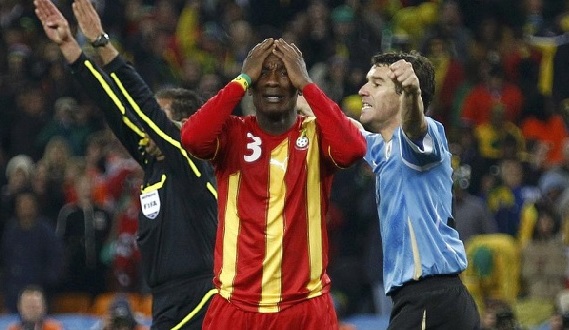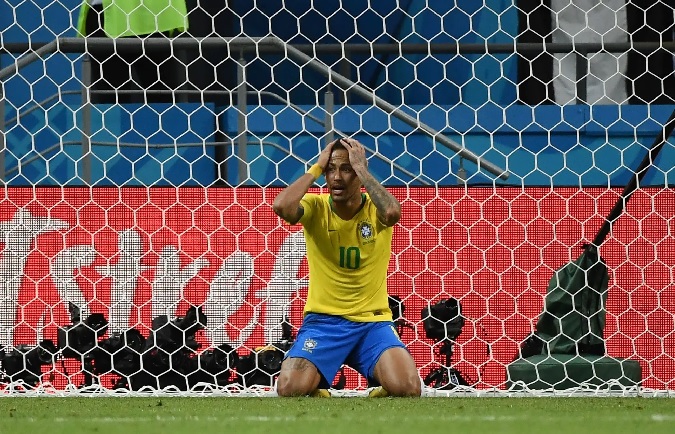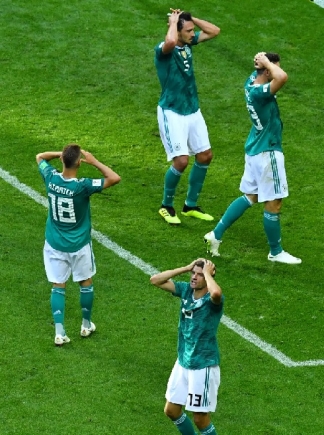
Why do footballers put their hands on their heads when they miss shots or lose matches?
Watch any football match from the Premier League through to your local primary school friendly, and it's always the same.
Footballers who miss what was apparently an easy goal immediately clap their hands to their heads.
We’ve seen it a hundred times in the World Cup: A player misses a shot and his hands immediately go to the top of his head.
Why? Psychology has the answer
Football fans may also adopt the posture when their team misses a chance. The most famous example of this was probably in 1999 during a match between Liverpool and Manchester United, when Michael Owen missed a chance at goal.
Soon after he was photographed head in hands. Two of his team-mates in the picture also have their hands on their heads - as does almost every single person behind them in the crowd.
Goals in soccer games can be few and far between, which helps explain the delirious nature of most scoring celebrations. Some players yank off their jerseys or drop to their knees and glide across the turf in glee. They all often end up at the bottom of a pile of jubilant teammates.

Then there are the players who are presented with a goal-scoring opportunity and, for whatever reason, fail. When this happens, they all do the same thing: raise their hands and place them on their heads — apparently the universal gesture to signify, How in the world did I miss that?
If you’ve followed the World Cup this summer, you’ve most likely seen it dozens of times, by players from every position and every country.
Lionel Messi has done it, and so has Cristiano Ronaldo. France, Belgium, England and Croatia have all advanced to the semifinals, but their players, too, have struck the disappointed pose.
It has nothing to do with soccer and everything to do with the human psyche, according to zoologists, psychologists and others who study such things.
The gesture signifies that “you know you messed up,” said Jessica Tracy, a professor of psychology at the University of British Columbia. “It’s going to tell others, ‘I get it and I’m sorry, therefore you don’t have to kick me out of the group, you don’t have to kill me.”
It’s not limited to the shooter, either. In one of the most replayed soccer blunders of all time, from the 2010 World Cup, Yakubu Aiyegbeni of Nigeria missed an empty net from about 10 feet away.

Though Aiyegbeni hardly moved afterward, nearly every one of his teammates and coaches made the gesture in immediate and unrehearsed synchronization.
In his seminal 1981 study of the sport, “The Soccer Tribe,” the zoologist Desmond Morris included the gesture in his catalog of 12 player reactions to defeat.
He noted its function of self-comfort, which he described as “a form of auto-contact, a widespread device used when the individual feels in need of a reassuring embrace, but has no one immediately available to offer one.” It’s seen among nonhuman primates as well.
In 2008, Tracy published an influential study with her colleague David Matsumoto, in which they studied the gestures of both victory and defeat made by sighted and congenitally blind Olympic athletes.
They found evidence to suggest that the display behaviors of pride and shame were innate and universal.
“You have the head in the hands — that’s shame,” Tracy said. “You have the constriction of the body, in the way that the player is moving his arms around his head, almost to make himself smaller. Those are very classical shame display elements.”
No one knows better than the players when they mess up. Cobi Jones, who had a long career with the United States men’s national team and now works as a TV analyst, said in a telephone interview that a blatant miss triggers, along with the gesture, a sense of disbelief and embarrassment.
“That’s what we train for, day in and day out, to put that ball in the net,” he said. “And that’s a simple one. It’s one that you shouldn’t miss.”
The gesture is also commonly made after a goalkeeper makes a spectacular save to prevent what otherwise would be a sure goal. One of the most famous examples came in the 2006 World Cup final.
![]()
Late in extra time of a tie game, the French star Zinedine Zidane snapped a header that he thought was destined to win the tournament, only to see the Italian goalkeeper, Gianluigi Buffon, nudge the ball over the crossbar with his fingertips. Zidane’s hands went straight to the top of his balding head.
Whether the ball misses the net because of a gaffe by the shooter or a spectacular save by the goalkeeper, the response by the rejected players remains nearly identical.
“It’s exactly the same statistical reality,” the British soccer historian David Goldblatt said. “You have your chance. You miss it, a goalkeeper saves it, whatever. The mechanism by which you get to that point is neither here nor there.”
Jones described the offensive player’s experience in both cases as “shock.”
“When people get startled unexpectedly, their hand will sort of move up to their head almost in a protective motion,” said Dacher Keltner, a professor of psychology at the University of California, Berkeley.
“The oldest kind of behavioral intention in that class of behaviors is to protect your head from blows.”
In 1996, Keltner published a study of people’s emotional reactions to sudden blasts of noise. The subjects of that study had reaction similar to that of soccer players after a near miss.
“You hear a really loud sound and that’s in the world correlative that something might hit your head, and you defend your head, which is vulnerable and critical,” Keltner said. “Any kind of action like the near miss, the source of psychic pain will produce those head protective movements.”
The basic gesture might be accompanied by subtle add-ons. Players might cover their faces with their hands or jersey, another typical shame display.
Or they might tilt their head upward to the sky in what Goldblatt sees as “asking for the miss to be interpreted as a consequence of the fates rather than their own mistake.”
“When people feel awe-struck, they look up,” said Keltner, who has spent time with the Golden State Warriors’ coaching staff discussing his work on compassion.

Something he observed from that experience was that “serious athletes recognize chance more so than fans.” The look to the sky, he said, could be the player’s “recognition of something beyond human agency.”
The hands-to-the-head gesture is also performed by fans at the same moments as the players. Since they are observers rather than participants, their motivations could differ. Philip Furley, a lecturer in sports psychology at the German Sports University, in Cologne, has studied players’ behavior during penalty kicks, when the gesture is common.
Among the spectators, Furley said, “what you often find is this sort of contagion going on. If it’s a team you support, then if this player you’re supporting in this moment shows something you might be infected by his nonverbal behavior.”
No matter the cause, the near absolute predictability of the gesture has become its most defining trait. “It’s like punch lines, catchphrases that comedians use,” Goldblatt said. “People start laughing before you say them. A lot of comics work on that.”
In this case, soccer players and fans don’t need to work on the gesture. It seems to come naturally.
Source: The New York Times
